Review
of the Canon EF 24-105mm f/4L IS USM Lens
Comparison
with Canon EF 28-135mm f/3.5-5.6 IS and Canon EF 24-70mm f/2.8L lenses
|
This report briefly reviews and compares the performance of the
Canon EF 24-105mm f/4L IS lens against two other excellent performing
Canon zoom lenses: 1) EF 24-70mm f/2.8L; and 2) EF 28-135mm f/3.5-5.6
IS. All three lenses performed remarkably well with only relatively
small differences in performance being detected in the tests. All
three lenses offer excellent sharpness and contrast across their
aperture and focal length ranges and resistance to flare. Differences
were noted in linear distortion, vignetting, out of focus highlights,
resolution at f/8 and lateral chromatic aberration. The two expensive
L-zoom lenses predictably outperformed the consumer quality EF
28-135mm lens on many tests. However, the differences in image quality
that end up being visible in a print are surprisingly small.
|
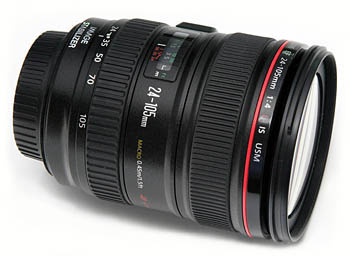 |
Summary Conclusions/Opinions
EF 24-105mm f/4L IS
Strengths:
This 4.4x constant aperture L-zoom lens provides close to
the perfect focal length for event photography (e.g., weddings,
receptions) as well as travel photography with a full frame camera.
Sharpness and contrast are very good wide open at f/4, but improve if
stopped down to f/5.6. Image stabilization is useful in low light, and
superb L-quality build make it a lens that will survive heavy use under
moist and dusty conditions. It is relatively light and compact (only being
slightly larger and heavier than the 28-135 consumer lens.) It has the
least amount of lateral chromatic aberration of the three lenses tested.
Weaknesses:
The near perfect focal length range comes at the expense of greater linear
distortion and vignetting (light drop off). At 24mm, there is moderate
barrel distortion. At 100mm, there is moderate pincushion. The vignetting
almost disappears by f/8. For most photographic applications, the
vignetting and barrel distortion generally will not be noticeable.
EF 24-70mm f/2.8L
Strengths:
This 2.9x constant aperture L-zoom lens produced high
quality images that were most free of distortion and vignetting of the
three lenses. Very sharp, high contrast images were produced over the
widest aperture range. The 24-70 noticeably outperforms the 24-105 at
24mm. The f/2.8 aperture is very useful for low light shooting conditions
when you want to stop motion and for background control with pleasing
bokeh. Autofocus function under low ambient lighting conditions is
noticeably faster with this f/2.8 lens than with narrower aperture lenses.
This quality L-lens has been previously reviewed
here.
Weaknesses
(picking nits): If you are shooting an event/wedding with
one lens, you will find times when you wish the 24-70 were a little longer
(e.g., 85 or 90mm). If you are shooting events with two bodies and lenses
or can move in closer, this isn't a problem. This lens has a little more
lateral chromatic aberration than the 24-105. It is a large, heavy lens
that may be objectionable to some if you have to carry it around for a day
with other equipment.
EF 28-135mm f/3.5-5.6 IS
Strengths:
If you can stop this lens down to f/8 or f/11, this 4.8x
variable aperture consumer zoom lens provides excellent imaging quality at
1/3 the cost of the 24-105 L-lens. It is light and reasonably well
constructed for light-duty use with very good image stabilization
function. For many photographic applications, I can't differentiate image
quality produced by it and expensive L-zooms. Even though the L-zooms give
slightly higher resolution at f/8 than the 28-135, this slightly higher
resolution is generally not noticeable in prints smaller than 8x10. This
is a great travel lens with the EOS-5D, despite the introduction of the
24-105. I wrote an earlier review of this lens based mostly on film camera
performance here
using a different lens sample.
Weaknesses:
The greater zoom range of the 28-135 is associated with
linear distortion at the zoom ends as well as vignetting and mild
chromatic aberration. Image quality doesn't hold up to large print
enlargement if you shoot at apertures wider than f/8 or f/11 compared to
the L-zooms. There are many times where you want to control background by
opening up aperture, and your options with the 28-135 lens are limited.
Good photographic skills can often overcome these limitations.
There
is an obvious big difference between construction quality of this consumer
zoom and that of the L-zooms. The consumer quality build of the 28-135
should hold up to careful use for many years. This lens is constructed of
light-weight materials, is not sealed and is much more susceptible to
moisture, dust and heavy-use structural wear than the L- zooms.
Other
28-135 users have posted reviews of poor performance and poor
build quality for this lens, so there may be quality variability in the
production of this consumer lens. I have owned two of them, and both have
performed very well stopped down to f/8 or f/11 and have had good build
quality.
50% MTF and Contrast Performance
Data
The tests I ran indicated that there were smaller
differences in 50% MTF and contrast performance among the three lenses
than in any previous tests of multiple lenses I have run. All three lenses
performed remarkably well.
Methods used to calculate 50% MTF and
contrast from RAW images with an EOS-1Ds Mark II were comparable to
these
with the exception that differing working distances were used for each
focal length. MTF/Contrast values should only be
compared within a review and not between reviews since conditions varied
between lens reviews for these test parameters.
| 28mm |
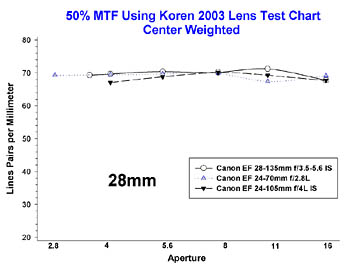 |
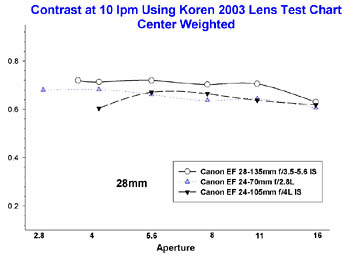 |
|
| 50mm |
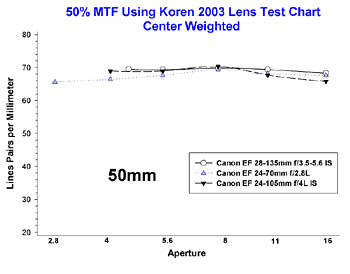 |
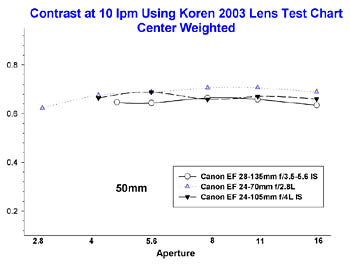 |
|
| 85mm |
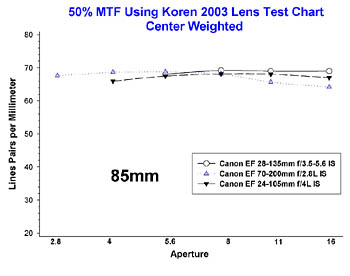 |
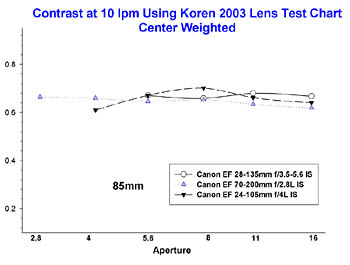 |
|
| 100mm |
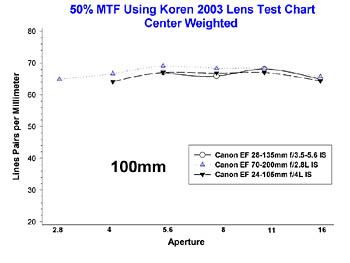 |
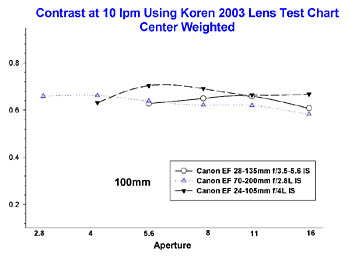 |
|
| 135mm |
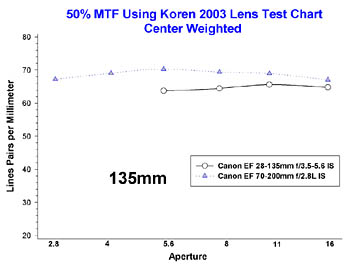 |
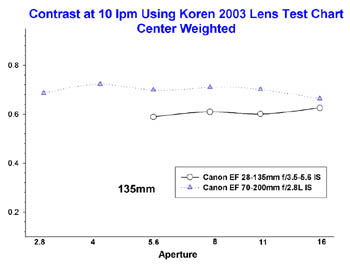 |
|
I considered the possibility that RAW processing software was obscuring
or compensating for differences in lens performance and repeated the
analysis using in-camera large jpgs. Similar results from in-camera jpgs
were obtained and are presented
here.
Vignetting, Linear Distortion,
Sharpness, Chromatic Aberration with an EOS-1Ds Mk II
Corner image sharpness, linear distortion, vignetting, and lateral
chromatic aberration (CA) varied among the lenses tested.
In the
following tables, sharpness and resolution summaries are provided. Corner
image performance examples below are from the upper left corner of
this
chart. Resolution is quantitative and recorded from the
images of the USAF 1951 pattern on the Edmund Scientific chart. The
assessment of sharpness is qualitative. The field was recorded as mildly
soft, sharp, or very sharp when it looked mildly soft, sharp or very
sharp. Factors influencing sharpness included resolution, contrast,
freedom from chromatic aberration, and field illumination. In the center
of the field, there was generally good agreement between resolution values
and the degree of sharpness. In the corners, there was less agreement
since a lens might resolve line pairs at 44 lp/mm, but still give a soft
appearing image because of lack of contrast, chromatic aberration and
uneven illumination (vignetting or light drop off).
24mm
Vignetting and Linear Distortion - 24mm
Corner Sharpness and Chromatic Aberration (CA) - 24mm
| Aperture |
EF 24-105mm f/4L IS
(resolution
lp/mm) |
EF 24-70mm f/2.8L
(resolution
lp/mm) |
EF 28-135 f/3.5-5.6 IS |
| f/8 |
f/8
Minimally
soft (44)
Mild CA |
f/8
Sharp
(50)
Moderate CA |
|
| f/5.6 |
f/5.6
Mildly
soft (44)
Mild CA |
f/5.6
Mildly
soft (50)
Moderate CA |
|
| f/4 |
f/4
Mildly
Soft (39)
Mild CA |
f/4
Mildly
soft (50)
Moderate CA |
|
| f/2.8 |
|
f/2.8
Mildly
soft (44)
Moderate CA |
|
Central Sharpness - 24mm
| Aperture |
EF 24-105mm f/4L IS
(resolution
lp/mm) |
EF 24-70mm f/2.8L
(resolution
lp/mm) |
EF 28-135 f/3.5-5.6 IS |
| f/8 |
f/8
Very
Sharp (50) |
f/8
Very
Sharp (50) |
|
| f/5.6 |
f/5.6
Very
Sharp (50) |
f/5.6
Very
Sharp (50) |
|
| f/4 |
f/4
Very
Sharp (50) |
f/4
Very
Sharp (50) |
|
| f/2.8 |
|
f/2.8
Sharp
(44) |
|
28mm
Vignetting and Linear Distortion - 28mm
Corner Sharpness and Chromatic Aberration (CA) - 28mm
| Aperture |
EF 24-105mm f/4L IS
(resolution
lp/mm) |
EF 24-70mm f/2.8L
(resolution
lp/mm) |
EF 28-135 f/3.5-5.6 IS
(resolution
lp/mm) |
| f/8 |
f/8
Sharp
(50)
Minimal CA |
f/8
Very
Sharp (55)
Mild CA |
f/8
Sharp
(44)
Mild CA |
| f/5.6 |
f/5.6
Minimally
soft (44)
Minimal CA |
f/5.6
Sharp
(50)
Mild CA |
f/5.6
Minimally
soft (44)
Mild CA |
| f/4 |
f/4
Minimally
soft (44)
Minimal CA |
f/4
Minimally
soft (44)
Mild CA |
f/4
Mildly
soft (39)
Mild CA |
| f/2.8 or f/3.5 |
|
f/2.8
Soft
(44)
Mild CA |
f/3.5
Mildly
soft (44)
Mild CA |
Central Sharpness - 28mm
| Aperture |
EF 24-105mm f/4L IS
(resolution
lp/mm) |
EF 24-70mm f/2.8L
(resolution
lp/mm) |
EF 28-135 f/3.5-5.6 IS
(resolution
lp/mm) |
| f/8 |
f/8
Very
Sharp (50) |
f/8
Very
Sharp (50) |
f/8
Sharp
(44) |
| f/5.6 |
f/5.6
Very
Sharp (50) |
f/5.6
Very
Sharp (50) |
f/5.6
Sharp
(44) |
| f/4 |
f/4
Sharp
(44) |
f/4
Sharp (50) |
f/4
Sharp
(44) |
| f/2.8 or f/3.5 |
|
f/2.8
Minimally
Soft (39) |
f/3.5
Mildly
Soft (39) |
50mm
Vignetting and Linear Distortion - 50mm
Corner Sharpness and Chromatic Aberration (CA) - 50mm
| Aperture |
EF 24-105mm f/4L IS
(resolution
lp/mm) |
EF 24-70mm f/2.8L
(resolution
lp/mm) |
EF 28-135 f/3.5-5.6 IS
(resolution
lp/mm) |
| f/8 |
f/8
Sharp
(50)
Negligible CA |
f/8
Very
Sharp (50)
Minimal CA |
f/8
Sharp
(50)
Mild CA |
| f/5.6 |
f/5.6
Minimally
Soft (44)
Negligible CA |
f/5.6
Sharp
(50)
Minimal CA |
f/5.6
Minimally
Soft (44)
Mild CA |
| f/4 or f/4.5 |
f/4
Minimally
Soft (44)
Negligible CA |
f/4
Minimally
Soft (50)
Mild CA |
f/4.5
Minimally
Soft (44)
Mild CA |
| f/2.8 |
|
f/2.8
Mildly
Soft (44)
Mild CA |
|
Central Sharpness - 50mm
| Aperture |
EF 24-105mm f/4L IS
(resolution
lp/mm) |
EF 24-70mm f/2.8L
(resolution
lp/mm) |
EF 28-135 f/3.5-5.6 IS
(resolution
lp/mm) |
| f/8 |
f/8
Very
Sharp (50) |
f/8
Very
Sharp (50) |
f/8
Sharp
(44) |
| f/5.6 |
f/5.6
Very
Sharp (50) |
f/5.6
Sharp (50) |
f/5.6
Minimally
Soft (39) |
| f/4 or f/4.5 |
f/4
Minimally
Soft (44) |
f/4
Sharp (50) |
f/4.5
Minimally
Soft (44) |
| f/2.8 |
|
f/2.8
Minimally
Soft (39) |
|
100mm
Vignetting and Linear Distortion - 100mm
Corner Sharpness and Chromatic Aberration -100mm
| Aperture |
EF 24-105mm f/4L IS
(resolution
lp/mm) |
EF 70-200mm f/2.8L IS
(resolution
lp/mm) |
EF 28-135 f/3.5-5.6 IS
(resolution
lp/mm) |
| f/8 |
f/8
Minimally
Soft (44)
Negligible CA |
f/8
Very
Sharp (55)
Negligible CA |
f/8
Minimally
Soft (44)
Mild CA |
| f/5.6 |
f/5.6
Minimally
Soft (44)
Negligible CA |
f/5.6
Sharp
(50)
Mild CA |
f/5.6
Mildly
Soft (39)
Mild CA |
| f/4 |
f/4
Mildly
Soft (39)
Negligible CA |
f/4
Minimally
Soft (44)
Mild CA |
|
| f/2.8 |
|
f/2.8
Mildly
Soft (39)
Mild CA |
|
Central Sharpness - 100mm
| Aperture |
EF 24-105mm f/4L IS
(resolution
lp/mm) |
EF 70-200mm f/2.8L IS
(resolution
lp/mm) |
EF 28-135 f/3.5-5.6 IS
(resolution
lp/mm) |
| f/8 |
f/8
Sharp
(44) |
f/8
Sharp
(50) |
f/8
Mildly
Soft (39) |
| f/5.6 |
f/5.6
Sharp
(44) |
f/5.6
Sharp
(44) |
f/5.6
Mildly
Soft (39) |
| f/4 |
f/4
Minimally
Soft (44) |
f/4
Sharp
(44) |
|
| f/2.8 |
|
f/2.8
Mildly
Soft (44) |
|
Central image sharpness varied among the lenses tested. There was no
central chromatic aberration. Examples below in the table are from the
center of this
chart.
Other Photographic Tests
Building
/ Landscape Test Target at 40mm and f/11
Slight
differences in sharpness are more attributable to slight focus
differences than intrinsic lens sharpness. All three lenses performed
very well in this test. |
 |
Mannequin
Test Target at 70mm
You can see slight differences
in sharpness (especially between the L-lenses and the 28-135mm lens at
wide open apertures). Overall, all lenses produce images with excellent
contrast and good to excellent sharpness for portrait application. |
 |
Resistance
to Flare
Monolight fired directly into lens. All
three lenses are resistent to flare. All tests run at about 70mm. The EF
24-70 at f/2.8 shows relatively minor flaring with an internal
reflection. |
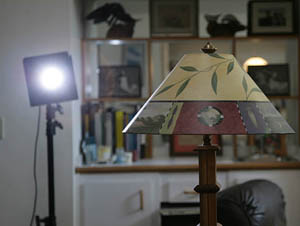 |
Out
of Focus Light Patterns
There are minimal
differences in the patterns of out of focus background lights among the
lenses. The 24-70 produces the smoothest out of focus backgrounds
(bokeh). The 28-135 shows hexagonal aperture out of focus lighting
pattern. All tests were run at about 70mm. |
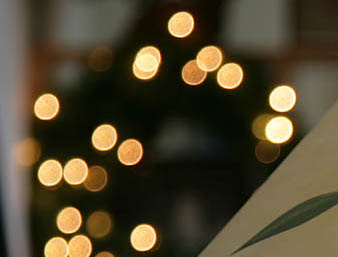 |
Equipment
Review Index
Home
©
2006, William L. Castleman
Initially
posted 10 June, 2006, updated 15 June, 2006














